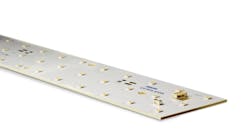Philips Lumileds announces board-level modular LED light engine
So-called Level 2 Matrix Platform products from Lumileds with LEDs integrated on PCBs will enable SSL product developers to accelerate time to market in specific applications such as troffers and linear cove lighting.
Philips Lumileds has announced the Matrix Platform including the Luxeon XR and XF family of modular LED light engines that consist of LEDs mounted on rigid or flexible printed circuit boards (PCBs) as a building-block product for solid-state lighting (SSL) developers. Lumileds, and others in the SSL industry, refer to such PCB-based products as Level 2 products differentiating the customer engagement from Level 1 products or individual packaged LEDs. The initial Luxeon Matrix products target troffers and other linear applications.
Packaged LEDs are increasingly difficult for some lighting manufacturers to work with at the component level. Both mid-power LEDs and high-power devices in flip-chip or chip-scale packages (CSPs) require automated assembly on high-end surface-mount device (SMD) production lines. Indeed, when Lumileds first pioneered the CSP LED last year, the company said many customers would buy products that use the LED in a Level 2 engagement with the LEDs already mounted on a PCB, thereby simplifying both the product development and manufacturing processes.
The Matrix Platform is meant to offer the aforementioned benefits in form factors that are optimized for specific applications. "More than ever, luminaire manufacturers need robust solutions that meet their specific design requirements. That need, together with today’s time-to-market pressures, inspired our Matrix Platform," said Viral Hazari, product line director for the Matrix Platform at Lumileds. "Based on customer requirements, Philips Lumileds can provide Luxeon XR and Luxeon XF solutions designed with any Luxeon LEDs. Additionally, there are both off-the-shelf and built-to-spec options."
The initial Matrix press release covered specifically the off-the-shelf XR and XF families that use Lumileds mid-power Luxeon 3535 LEDs. The Luxeon XF-3535L product family features a single row of LED components mounted on a flexible PCB in strip fashion for applications ranging from cove lighting to T8 LED tubes. The Luxeon XR-3535L products feature rigid PCBs with a by-3 arrangement of LEDs with two series of components mounted parallel to one another. The XR products target applications ranging from ceiling troffers to outdoor area lights.
Developers will get an initial choice of 3000K, 3500K, or 4000K CCTs in the XR family with all of the products specified at a CRI of 80. The PCB measures 280×55 mm about (11×2.2 inches). Typical lumen output ranges from 1320–1419 lm with efficacy in the 142–152-lm/W range. The form factor is also compliant with some Zhaga Consortium books.
The XF series comes in far more configurations for now with CCT ranging from 2200K to 5700K and module lengths of 300, 525, 600, or 1150 mm. At 2700K flux output varies from 1080–3240 lm across 300–600-mm versions of the product. Efficacy varies broadly with CCT from 112–157 lm/W.
Still, long term it may be flexibility in configurations of the modules that will be most valuable to developers. Lumileds emphasized that it will offer custom options in terms of LED types and form factor.
"Philips Lumileds sees manufacturers quickly moving toward boards and modules to meet their time-to-market goals and indeed we have been working with select customers for some time to understand and enhance the value we could provide with these solutions," said Hazari. Philips said its production line in Penang, Malaysia dedicates 12,000-ft2 of capacity to Matrix Platform products. "We can rapidly turn around new designs -- in many cases within two weeks of design approval," added Hazari.

Maury Wright | Editor in Chief
Maury Wright is an electronics engineer turned technology journalist, who has focused specifically on the LED & Lighting industry for the past decade. Wright first wrote for LEDs Magazine as a contractor in 2010, and took over as Editor-in-Chief in 2012. He has broad experience in technology areas ranging from microprocessors to digital media to wireless networks that he gained over 30 years in the trade press. Wright has experience running global editorial operations, such as during his tenure as worldwide editorial director of EDN Magazine, and has been instrumental in launching publication websites going back to the earliest days of the Internet. Wright has won numerous industry awards, including multiple ASBPE national awards for B2B journalism excellence, and has received finalist recognition for LEDs Magazine in the FOLIO Eddie Awards. He received a BS in electrical engineering from Auburn University.






